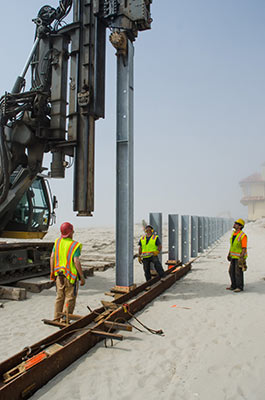by Brianna Crandall — November 11, 2015—The U.S. Commerce Department’s National Institute of Standards and Technology (NIST) recently issued the new Community Resilience Planning Guide for Buildings and Infrastructure Systems to help U.S. communities better withstand and rebound from the shocks of severe weather, earthquakes and other hazards.

Construction of baffle walls on New York’s Rockaway Beach following Hurricane Sandy. Credit: K.C. Wilsey / FEMA
Issued on the third anniversary of Hurricane Sandy, which killed 157 people in the United States and wreaked havoc and destruction from Maine to North Carolina, the new planning guide is aimed at community leaders in both the public and private sectors.
The guide lays out a practical six-step process that communities can follow to develop resilience plans to help them prepare for hazards, adapt to changing conditions and withstand and rapidly recover from disruptions.
U.S. Commerce Secretary Penny Pritzker commented:
Given the breadth of impact extreme weather is having on American lives and commerce, it is clear that we have to do more to mitigate its effects. Improving local resilience efforts are a challenge that every city should address, and this planning guide can assist communities in developing preparedness plans to prevent hazards from becoming disasters.
Community Resilience Planning Guide for Buildings and Infrastructure Systems is available from the NIST Web site, along with a Guide at a Glance (12-page overview of the Guide and six steps for community resilience) and a Brochure (four-page overview).
NIST also published a feature story on the planning guide and other complementary NIST community resilience efforts: “Helping to Build a Nation of Resilient Communities.”
See also “NIST releases draft community resilience planning guide for public review” on FMLink.





